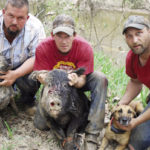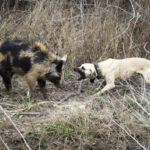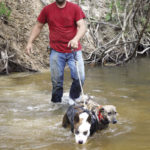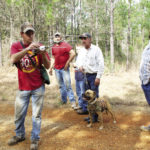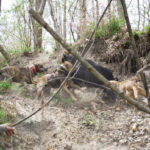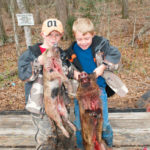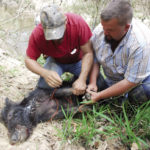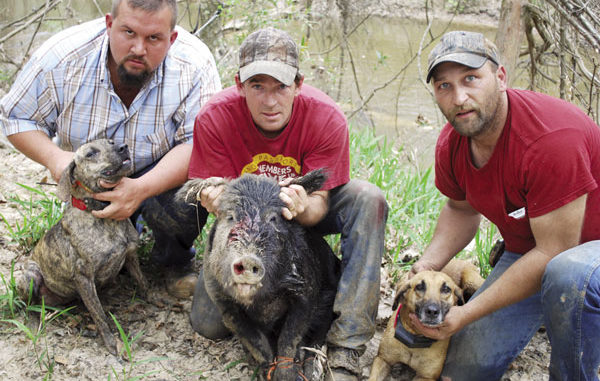
Got too many hogs on your property? Give these guys a call. They hunt the tasty creatures year-round, and have the briar scratches on their arms to prove it.
The first time I ever laid eyes on Josh Sandel, at the campground on Three Rivers Wildlife Management Area, he reminded me of a big dominant male silverback gorilla. As he sauntered up to me, the rest of the dozen and a half or so people camped together in the group stepped aside to let him pass.
It was obvious that the respect shown wasn’t just for his size, although at 6-1 and 280, he certainly had that. Holding a plate of scrambled eggs in one hand, the goateed giant fixed a level gaze at me as I admired the utility trailer full of dead hogs that he and his party had dispatched that morning.
“What can I do for you?” rumbled out of his barrel chest. The voice was surprisingly gentle. I expected an aggressive roar, and maybe a couple of chest thumps.
When I explained that I was interested in learning more about hog hunting, his face dissolved into a huge smile. I had asked the right question. Sandel had a passion for hog hunting.
Three weeks later, I was on my way to Florien to hunt with Sandel. I didn’t know what to expect. From what I had seen when we first met, the hog men and hog dogs of No Man’s Land looked as tough and hard-edged as scrap iron.
No Man’s Land, also called the Sabine Free State, the Neutral Ground, Neutral Strip or Neutral Territory, was an area of disputed status that was completely lawless from 1806 to 1821. It extended from what is now Sabine Parish in the north to northern Calcasieu Parish in the south, and from the Sabine River eastward to the Calcasieu River, and Bayous Kisatchie, Don Manuel, Lac Terre Noir and the Arroyo Hondo.
Neither Spain nor the young United States policed the area, and it rapidly became a haven for desperadoes, outlaws, deserters, fortune hunters and ruffians. Although “pacification” was begun by the U.S. in 1822, the area still today has a reputation for being suspicious of outsiders.
And I was an outsider.
But Sandel and his family made me feel right at home. Over supper the night before the hunt, Sandel and his wife Lacey, both college-educated, explained that they have “country roots and country values.” They try to live off the land.
“We make a big garden,” said Sandel, “we make our own sausage, eat a lot of wild game and any kind of fish.”
“Country as cornbread,” I suggested.
Sandel grinned and nodded.
Early the next morning, after Sandel loaded up his two brindle cur bay dogs, Queen and Turbo, and his muscular catch dog, Diesel, we set off to meet his day’s hunting partners at a 5,500-acre deer lease west of Hornbeck. The leasers want their hog population thinned out.
“Feral hogs done took over this part of the country,” Sandel drawled on the way over to the lease. “Their population has exploded. Being a hog hunter makes you a popular man most of the time.
“I hunt hogs 12 months a year. In July and August I don’t hunt them as much as the rest of the year, but I do hunt all year. During those really hot months, I get up at 3 a.m. and start hunting. By 9 a.m., I’m done. During most of the year, I hunt an average of three days a week.”
Hunting with Sandel was his most regular hunting partner, Jason Jeane, and his father Dale, both of Anacoco, and Kelvin Hicks and his son Kolton of Hornbeck. Effete snob hunters, these are not. All drive pick-ups that look like battle-scared war chariots, and not a speck of designer camo clothing is to be seen on any of them.
The younger Jeane brought three bay dogs, yellow blackmouth curs named Anne, Luke and Yella, and his catch dog Grasshopper, a littermate to Sandel’s Diesel. The two catch dogs are pit bulldogs mixed with some American bulldog. Hicks contributed his own black catch dog, Striker, and a young yellow bay dog named Dan.
Like rehearsed professionals, the hunters scattered over the lease, which was cloaked in almost pure stands of various-aged managed pine trees, to find the hogs. They found plenty of old tracks, but no fresh sign and the dogs scented no hogs.
“They done moved,” Sanel said.
Dale Jeane agreed.
“The hogs are walking right now,” he said. “It’s after hunting season, and they don’t have deer feeders to depend on, so they’re moving.”
They loaded up and headed for one of the two leases that Sandel belongs to. The leases are big. One is 5,500 acres, and the other is 23,000 acres. While most members of the clubs are deer hunters, Sandel belongs to them primarily to hunt hogs and coons when deer season is closed.
Leaving Hicks at the trucks with the catch dogs, the other three hunters walked three bay dogs down a narrow right-of-way into a dense bay gall, the head of a small creek. The dogs fanned out to seek hogs.
On the way in, Sandel explained that their normal hunting procedure is to use the smaller, more lightly-built bay dogs to find the hogs and vigorously pursue them until they “bay up.” When hogs are bayed up, they have stopped running and taken a stand to face their tormenters. When this occurs, the hunters will approach with their catch dogs on leashes.
Once close to the action, these walking sledgehammers are unleashed to grab the hogs by some part of their heads and immobilize them.
“I like my bay dogs to hunt mostly silent until they bay up,” Sandel said.
Silent dogs don’t alarm the hogs as much as noisy dogs do. Once the hogs bay up, though, the dogs become wildly vocal, as I found out a few minutes later, when the three dogs began to frantically bark and bay.
The hunters hustled back to the trucks to get their catch dogs. When they reached the trucks, Sandel cocked his head.
“Something is going on,” he said.
He was hearing dogs that weren’t theirs barking at the site of the baying.
Almost immediately, chaos ensued. Dogs were going in every direction, baying frantically. A big black hog humped across the logging road behind us. Then silence followed.
“They broke,” said Sandel with disgust in his voice.
Hogs seemed to have gone in every direction. So the four men turned the rest of their bay dogs loose to try to get several bays working at a time.
While the hunters were unlimbering their telemetry receivers to determine where the dogs were, two strange hunters, with several dogs in tow, popped out of the brush. Somehow, it seemed, we had become inadvertently entangled with the other hog hunters and their dogs.
After they left, Sandel explained that the presence of so many dogs put so much pressure on the bayed hogs that they became nervous, broke and ran. Hogs and dogs had scattered everywhere. Signals from the telemetry collars on the dogs told the men that their dogs were trailing three separate hogs or groups of hogs in three different directions.
The chase began. The hunters used their trucks to cruise the dirt roads of the lease and the gravel and paved roads around the lease to keep up with the dogs and get as close as possible to where they would bay up. They kept in touch with each other by cell phones.
It was a big chess match, with the men frequently stopping and using their telemetry equipment to determine their next move. This went on for hours. The hogs were nervous. They mostly kept moving, and when they bayed up, they didn’t hold for long.
Round and round the trucks, dogs and hogs went.
“There’s lots of listening and tracking in this kind of hunting,” Sandel explained. “But when it happens, it happens. That’s when it gets exciting; that’s when it gets good. When the dogs are bayed, you never know what you got; it could be ‘Big Nasty.’ It could happen at any time.”
Sandel’s cell phone rang for what seemed like the umpteenth time, but this time the news was good. Hicks and his son had found Anne and Queen bayed up on a mature black hog on the very edge of the lease. Sandel and the two Jeanes closed in for the catch.
Sandel suggested that the men bring all three catch dogs. It’s unusual to turn more than one catch dog lose on a hog at once, but he explained that this hog had been bayed so long and the hogs had been so jumpy that he didn’t want to take a chance on it getting away.
The three muscular dogs on leashes led the men downhill through dense briars and saplings toward the sound of bedlam. The hairs on the back of my neck stood up in anticipation.
Emerging from the briars, scratched and bloody, the men saw a sight that can be described either as a scene of mayhem or beauty in motion.
The long-nosed rooter had taken a stand on one bank of a beautiful little sandy-bottomed, clearwater creek. The brindle dog and the yellow dog were frantically barking at the mature sow, one from each side. The hog responded by snapping its jaws, throwing slobber 3 feet in each direction and lunging at the dogs, which deftly dodged.
The men unleashed the catch dogs. Without any finesse, they slammed into the hog headfirst. Grasshopper hit the hog first. Water from the dogs’ coats, pig slobber and sand flew everywhere. Quickly Diesel and Striker joined the fray.
But the hog didn’t give up easily, slinging dogs in every direction. Finally she went down, squealing and screaming in anger and fear. The intensity of barking by the bay dogs only picked up. The catch dogs were silent, their mouths full of pig.
Quickly, the men hog-tied the pig and leashed the dogs to nearby trees. After a quick impromptu pose, they unceremoniously manhandled the trussed hog through the creek and up the hill. This hog, like most that the men catch, is destined for a holding pen, where it will be fed grain before being dispatched. If it had been a boar, they would have castrated it before it was penned.
The dogs were kenneled to join three of the other bay dogs that were intercepted earlier. Only the blackmouth cur Yella was still on the loose, and he was hot on the trail of another pig, six hours after being turned loose.
The end came quickly. The hog, a spotted shoat, bayed up near a road, making it almost too easy for the men.
As the dusty, tired hunters lean on the fenders and hoods of their pick-up trucks, I looked over to Dale Jeane, at 54, the oldest man on the hunt.
“What are you going to do when you get too old to do this?” I asked.
He thought a minute, studying the question before answering.
“That would be bad, but it wouldn’t be as bad as still being able to hunt and losing the right to hunt with my dogs.”
